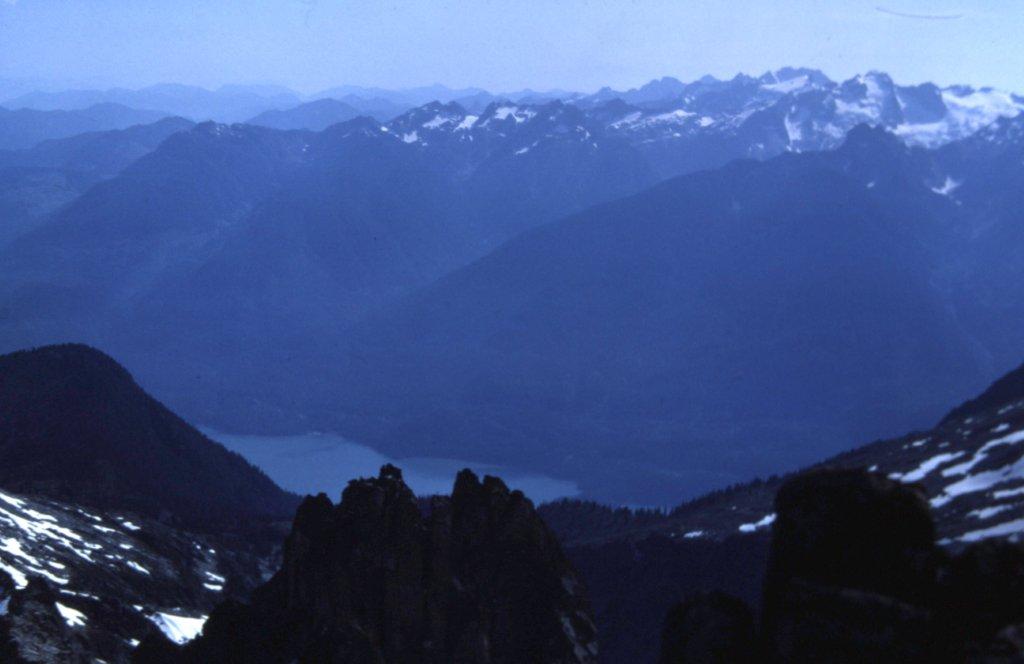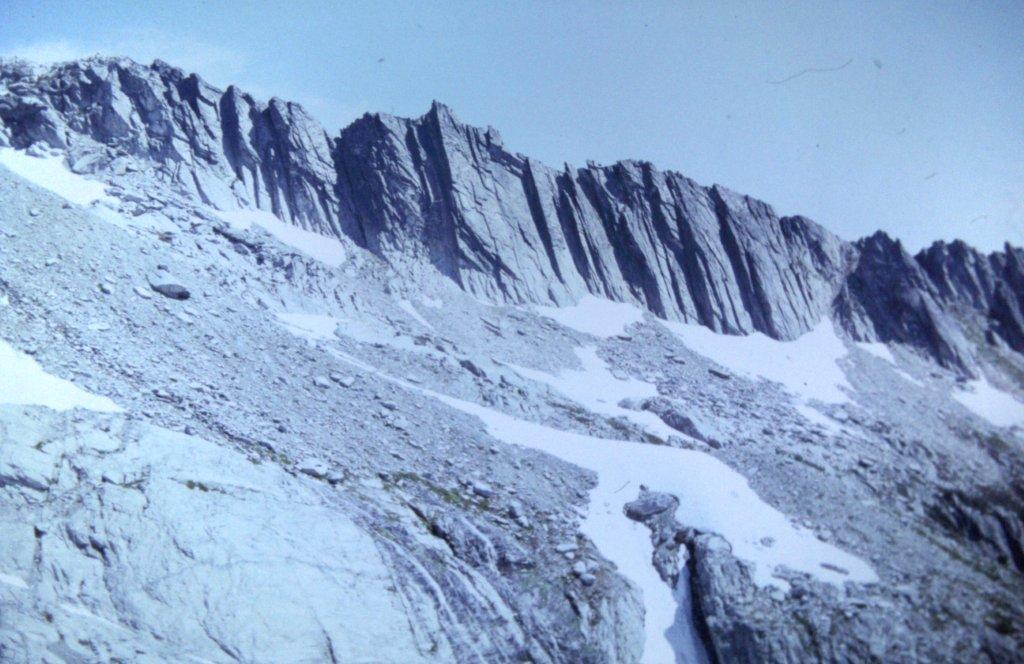When I think back on my early days of climbing, I realize I did some pretty ballsy stuff, took a lot of risks I maybe shouldn’t have. But if I hadn’t, I wouldn’t have all these great memories to entertain me in my doddering old age now, would I. Here’s an example.
It was the summer of 1975, and I was restless to get back into the mountains. It had been all of four days since I had last climbed something, and the weather was perfect. That’s saying something for coastal British Columbia. Came the morning of August 8th, my wife drove me to the dock of Riv-Tow at the southern end of Harrison Lake. They operated a water taxi which ran up and down the 50-mile-long lake, supplying the various logging camps and catering to the whims of the lunatic fringe such as yours truly. From the village of Harrison Hot Springs, you could look north straight up the lake and see a big mountain, perpetually white with snow and ice. Even at the end of summer, it wore its white crown. I was mesmerized by it, and daydreamed of finding a way of getting to it and standing on its summit.
Mt. Breakenridge was its name. What little I knew of it had been gleaned from a book which had been published only months before. Alpine Guide to Southwestern British Columbia, written by Dick Culbert, who had been a fellow geology student at the University of BC in Vancouver, was an instant success. It quickly became my bible. The only reference available at the time, it covered a large area at the edge of which I happened to live. This ambitious and much-needed work changed my life, inspiring me and many other climbers to head to the hills and explore.
The boat, named Redonda, piloted by Ed Reid, left early and always on time. It took several hours to make its way up the lake to my jumping-off point, so I had plenty of time to ponder my situation. My plan was to travel alone, on foot, many miles through remote and challenging terrain. If something happened to me, I’d be shit out of luck. Rescue would be a long shot – where would they even begin to look for me in that trackless wilderness? No, this was a do-or-die venture, and I had no intention of dying. Everything hinged on not making mistakes, not even one.
The captain set me down at the dock of the long-abandoned logging camp at the mouth of Stokke Creek. He wished me luck, then hit the throttle and quickly disappeared up the lake. There I stood, utterly alone and beginning to realize the magnitude of what I had undertaken. It was barely noon on a cloudless day. An old logging road led out of the quiet camp – I followed it northeast up the valley bottom for a few miles, watching it become steadily more overgrown. Using the old topographic map I carried, at length I made a decision to head up spur roads, taking me higher and higher up the southeast side of the valley. I met a bear en route, but thankfully he took off running and left me to my own devices. By the time I called it a day, I had climbed 5,100 vertical feet. I felt totally knackered, and knew for sure I was dehydrated. How? As I stood there taking a leak, surveying the valley below, I had a bladder spasm which crumpled me like a rag doll. Once I recovered, I drank my fill from a small stream nearby and felt a lot better. It had been a good day, getting that high with a full pack. The night was clear and chilly, but I slept well.
Rising at daybreak the next morning, I had something to eat and moved on. It took a while, but the bush thinned out and the slope lessened. At around 6,500 feet elevation, things started to level out. I was now above treeline, and soon made my way on to the Breakenridge Icefield. It was only two miles or so across this thing, and fairly flat. What a rush, being up there by myself! Although I had an ice axe and crampons with me, I didn’t really need them to gain those final thirteen hundred feet to the summit. The last stretch was on good rock, and before I knew it I stood on the summit. 7,858 feet above sea level, it felt like a million – I was the king of the world! It had taken five hours of climbing that morning to reach the top. I spent a while and soaked up the view. Too many years have passed since that day, almost 40, for me to remember if I left a summit register. If I didn’t find one there that day, then I would have left one, as that had already become my habit.
There I was, enjoying the view, when reality settled in – I needed to get down off this thing and find a way home. If I were to go back the way I had come in, it would mean waiting days at the lake shore for the boat to pass by on its next run. Oh, wait – I hadn’t told him to pick me up, so he wouldn’t even stop there! The camp was abandoned, so there was no reason for him to ever come by. My original plan was to traverse the mountain and exit via the south and east and come out at a logging camp on the Silver River. It was all unknown territory to me, but how hard could it be?
I headed down the rock and back on to the icefield, then started south. My first challenge was to cross the south ridge and get on the east side of it.
I managed this without too much trouble and there I was, in the huge basin which drained the entire south side of the peak. It looked like, if I trended southeast, I could get down out of this bowl and to the creek which drained the whole area. I put on my crampons and very carefully chose a path down through the glacier and snowfield which filled the entire upper part of the valley. Several crevasses gave me pause – being solo, I couldn’t make any mistakes – falling into one would have likely put an abrupt end to my climbing career. By the time I reached the lower end of the basin and had stepped off the last of the snow, I felt I had it made.
Right about where the ice and snow ended, at around 5,000 feet elevation, a big problem reared its ugly head. Unseen from above, a cliff band stretched all across the basin, and it was a real doozy. I had no rope, so there was no possibility of rappeling down anywhere. I stood on the top, looking over the edge at countless waterfalls cascading down into the valley below. In retrospect, it was a beautiful sight, but totally lost on me at the moment. I couldn’t see any obvious way to get down. It took a lot of walking along the edge before I finally found a place safe enough to downclimb and get below the cliff. I had burned a lot of daylight doing this, and guess what – there were more cliffs. I was never so glad to finally get below treeline, and that’s saying something in the coast rainforest.
Following the headwaters of the no-name creek, I continued to lose elevation as the bush thickened. The mega-rainfall in this area guaranteed all of the joys of Coast Range bush-whacking, and I was not to be disappointed. Steep ravines really played hell with my progess. Deadfall littered the forest floor. Several times, I was forced to cross the creek, whether I wanted to or not. This was usually done on fallen slippery trees over the whitewater creek. One wrong move would’ve been a disaster.
My blue skies had abandoned me as the day progressed and It had clouded over by late afternoon. By 8:00 P.M., I was totally shagged out – I had been moving pretty much non-stop for fourteen hours straight. Even though I was looking for a place to bed down for the night, nothing good came to light. Out of desperation, I settled on a mossy spot among tall trees in the forest. It wasn’t nearly flat, so I spent a very uncomfortable night contorted into an awful position on a slope. Then it started to rain as I lay there in my bivi bag (I hadn’t brought a tent, wanting to travel as lightly as possible). That was one long night.
My third day dawned, gray and overcast. The bush was sopping wet, so that made for extra fun as I lost the final 1,500 vertical feet descending the valley eastward. It took me three hours to do that. I found a place to ford the Silver River, and waiting for me on its far bank was a logging road. Back in 1975 when I did this climb, there was no logging activity at all in the entire valley I descended from Breakenridge to the Silver River – it was an untouched virgin country. Since then, logging has destroyed it. Anyway, once on the road, I started walking up the valley. Before I had started this climb, I had heard rumor of a camp upstream, and in an hour I found it.
It looked like any other logging camp, but perhaps because it was a Sunday, all was quiet. I finally found someone to talk to – he was incredulous upon hearing my story. It turned out that they had a radio in camp, which somehow could be patched in to the telephone system. He happily placed a call for me to my wife – I told her the climbing was done, all I had to do now was get back to town. Someone was leaving the camp soon and offered me a ride out. It took a couple of hours on the logging roads, but he got me out to Harrison Hot Springs where I had caught the boat. A little hitch-hiking with my pack got me the last 40 miles back to my home in the town of Mission.
In retrospect, I had been pretty lucky. No injuries, didn’t get lost, didn’t get eaten by any bears, and, best of all, I had climbed a great mountain. I was already planning the next one.
Thanks to Ross Lillie for the photos.
Please visit our Facebook page at https://www.facebook.com/pages/Desert-Mountaineer/192730747542690


